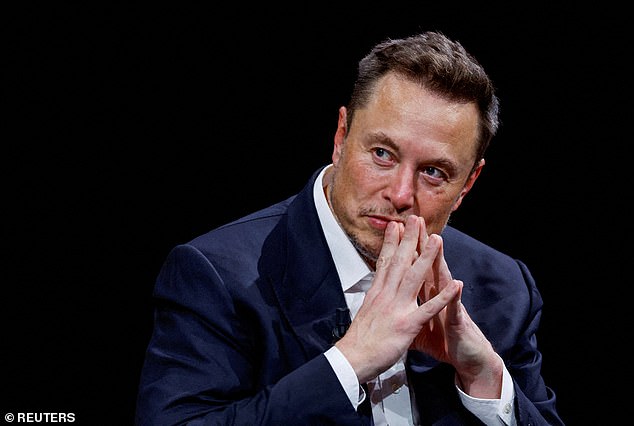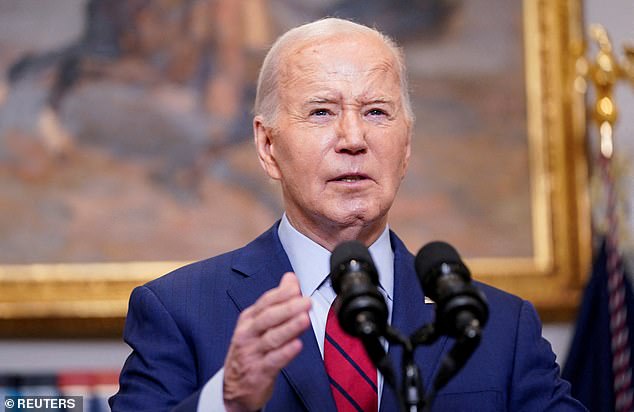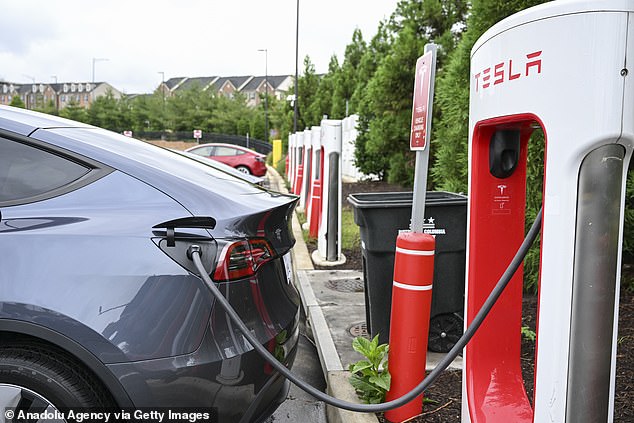How Elon Musk’s Tesla firing spree could nuke Biden’s plan for America to go fully electric by 2035
Elon Musk this week cut back most of Tesla’s supercharger workforce, severely derailing President Joe Biden’s plan to have only electric cars on the road by 2035.
The Supercharger is an EV charging bank that allows drivers to use the Tesla app to find available storage locations to plug in the vehicle and send a notification when the vehicle is fully charged.
These Superchargers were a cornerstone of Biden’s plan to reduce carbon emissions by making electric vehicles more practical. The most common reason Americans cite for not going electric is “range anxiety,” or the fear of a shortage of charging stations and that the vehicle’s battery charge won’t last long enough to complete a trip.
Although Musk has already installed 2,234 stations in the US, he planned to have tens of thousands by 2030 to boost the president’s EV initiative.
EV experts and officials told DailyMail.com that Tesla’s withdrawal from its agreements could simply open a door for other companies to step in – but admitted the 2035 timeline was unlikely.
Tesla has more than 50,000 Supercharger stations and had signed leases to open more locations when Elon Musk fired the entire Supercharger team

Elon Musk claims Tesla can still deliver Supercharging stations, but said it will just happen at a slower pace
Tesla halted construction of Supercharger locations in the US, including a dozen in Texas, and halted ongoing negotiations with property owners in New York.
The company was selected as the charging provider for at least one federally funded EV charging infrastructure in seven states, including Utah, Texas and Rhode Island, which could now go unfilled as a result of the layoffs.
Musk removed Tesla’s entire Supercharged team of around 500 people, and while he hasn’t confirmed what prompted the cuts, it follows a series of other layoffs as part of cost-cutting measures.
The layoffs were unusual because Tesla received $17 million in infrastructure grants as part of the Biden administration’s bipartisan infrastructure bill, which aimed to have 500,000 Supercharger stations installed by 2030.
In February, the White House said Tesla would make at least 7,500 open chargers for all electric vehicles by the end of 2024, including at least 3,500 new and existing 250-kilowatt Superchargers placed on highway corridors and at hotels and restaurants across the country.
It is now unlikely that Tesla will be able to meet those expectations despite Musk’s expectations claims that Tesla still plans to grow its Supercharger network, “but at a slower pace for new locations and more focus on 100% uptime and expansion of existing locations.”
“There is a lot of speculation about why the majority of the Supercharger team was let go, and only Musk can explain why,” Matt Teske, CEO of EV charging software platform Chargeway, told DailyMail.com, adding that “the timing of this decision is mainly what has baffled many in the EV industry.

Tesla’s major setback reportedly won’t hurt President Joe Biden’s ambitious goal of having 500,000 charging stations in urban and rural areas by 2030.

Tesla received $17 million in infrastructure grants under Biden’s 2021 Bipartisan Infrastructure Bill to install 3,500 charging stations in the US
In the wake of the Tesla layoffs, the Biden-Harris administration remains confident it will still be able to provide “a convenient, reliable, and equitable national EV charging network” to meet the public’s needs meet, a Joint Office of Energy and Transportation spokesman said.
The void has sparked a bidding war among companies to supply the charging stations Tesla had promised to build for automakers.
Kia, Honda and General Motors are among the companies that have signed agreements with Tesla to adopt the charging connector and gain access to all of the company’s Supercharger stations.
The spokesperson for the Joint Energy Transportation Agency said Tesla’s layoffs will not affect planned EV charging station projects.
“As a start-up company, Tesla approached automotive design and engineering by thinking differently,” Teske said.
The company was “proactive” when it created electric cars because it was targeting a market that didn’t exist, forcing existing car companies to adapt and “change the way they operate,” Teske said.
“To the Biden administration’s credit, they have worked to further boost automakers’ efforts in electric vehicle development and infrastructure deployment,” he continued.
“This will not only ensure that American automakers innovate their products to compete both domestically and internationally, but also create job growth in electric vehicle technology.”
The NYC Taxi and Limousine Commission said it continues to push its Green Rides Initiative, which identifies which locations would benefit most from EV stations.
“It is critical to provide our drivers with the charging infrastructure they need to protect their livelihoods and create a greener, more sustainable city,” said Jason Kersten, press officer for Taxi and Limousine.
“The Green Rides Initiative means that every provider doing business in NYC has a reliable, growing customer base, and one provider breaking a lease is a great opportunity for another to pick it up, especially if that location is power ready. ‘
In New York City, rideshare company Revel, which bills itself as using Tesla vehicles exclusively, has already agreed to acquire three of Tesla’s Supercharged leases, including locations at John F Kennedy International Airport, La Guardia Airport and a station with 20 outlets in the United States. Bronx.
“While Tesla is the leader in electric cars and proven electrification can be profitable, they will have to compete for mainstream buyers,” Teske said.
“This decision by Musk provides an opportunity for other companies to step up and prove their prowess in the EV customer experience, which will only fuel EV growth in the future.”
